Important Note
My sam and mayas att e-mail account was suspended on 18 DEC. Those who tried to reach me by e-mail between then and yesterday had their mails bounced back. If you tried to reach me during that period please re-send any important e-mails.
What’s Up?
Though I am still clearing the frogs from my throat a bit, I am feeling better this morning and had a lot more energy yesterday afternoon than on the preceding days. If you missed the Canon Digital Learning Center “Bird Photography with Arthur Morris” seven video series, be sure to click here for a link and the complete details. More on those here soon. I still have many more exciting new images, tales, and lessons from my recently concluded Southern Oceans trip to share with you here over the course of the next few weeks and am looking forward to doing just that.
Today’s blog post took about 2 1/2 hours to create in all and was published at 5:32am from my home at Indian Lake Estates, FL.
Huge Thanks!
Though page views dropped by about 35% during my absence y’all did a great job of remembering to use my B&H affiliate links while I was on my busman’s holiday. We sold about ten each of the new 100-400 II L IS lenses and 7D Mark IIs. I should be getting my 100-400 from B&H in a few days and plan on bringing it to San Diego where I will be using it with both my 7D II and a 1D X. IAC, thanks a stack to all those who use the BAA affiliate links for their December and early January purchases. Readership is now back at about normal with nearly 3,500 page views/day.
To show your appreciation for my continuing efforts here, we ask, as always, that you use our the B&H and Amazon affiliate links on the right side of the blog for all of your purchases. B&H Is recommended for you major photography gear purchases, Amazon for your household, entertainment, and general purpose stuff. Please check the availability of all photographic accessories in the BIRDS AS ART Online Store, especially Gitzo tripods, Wimberley tripod heads, and the like. We sell only what I have used, have tested, and can depend on. We will not sell you junk. We know what you need to make creating great images easy and fun. And we are always glad to answer your gear questions via e-mail. I just learned that my account was suspended during my absence; it should be up and running by Monday at the latest.
I would of course appreciate your using our B&H affiliate links for all of your major gear, video, and electronic purchases. For the photographic stuff mentioned in the paragraph above we, meaning BAA, would of course greatly appreciate your business. Here is a huge thank you to the many who have been using our links on a regular basis and visiting the BAA Online store as well.
|
This image was created in cloudy bright conditions at one minute after noon on January 5, 2015 at Neko Harbor, Antarctica with the hand held Canon EF 70-200mm f/2.8L IS II USM lens, the Canon Extender EF 1.4X III (at 240mm), and the amazing Canon EOS 7D Mark II. ISO 400. Evaluative metering +2 stop:s 1/4000 sec. at f/4 in Manual mode. One sensor to the right of the central sensor/AI Servo/Manual selection–single point/Rear Focus AF as framed was active at the moment of exposure. Click here to see the latest version of the Rear Focus Tutorial. Click on the image to see a larger version. Image #1: Wide View |
The Early Scene
In the “On the Way Home With My Favorite Flying Penguin Image” blog post here, I wrote, “After a nice hike up a pretty good snow-covered hill I spent an hour photographing several quite scenic Gentoo Penguin colonies. After I made my way back to the landing I began hearing fantastical tales of a huge feeding/bathing aggregation of Gentoos with dozens of birds jumping in and out of the water. I hustled to get on a Zodiac with only 4 other photographers.”
Within minutes we were approaching a large over-turned iceberg sprinkled with Gentoo Penguins We slowed the zodiac at a distance to create some wide images. Expedition photo leader Ron Neibrugge had done a program earlier on creating “animal-scapes” and that is exactly what we did. Then right before our eyes dozens of penguins began trying to jump out of the water up onto the iceberg. Most did not make it and crashed back into the bay after whacking their heads or necks against the ice.
Thanks to Ted Cheeseman for this e-mail exchange
am: What kind of ice were the penguins jumping onto in the two images below??? Glacier? Iceberg? Snow pack? Something else?
tc: Definitely iceberg, which means calved off a glacier. The exposure doesn’t leave a lot of surface texture but I think it’s a berg that has rolled over at some point.
am: thanks Ted. As the tide was dropping around the berg, I am assuming that the big berg was grounded. The receding tide resulted in more and more Gentoos crash landing as the jumped from the water.
|
This image was created in cloudy bright conditions at one minute after noon on January 5, 2015 at Neko Harbor, Antarctica with the hand held Canon EF 70-200mm f/2.8L IS II USM lens, the Canon Extender EF 1.4X III (at 180mm), and the amazing Canon EOS 7D Mark II. ISO 400. Evaluative metering +1 2/3 stops: 1/2000 sec. at f/6.3 in Manual mode. One sensor below the central sensor/AI Servo/Manual selection–single point/Rear Focus AF as framed fell on the edge of the ice where the blue met the white, was active at the moment of exposure. Click here to see the latest version of the Rear Focus Tutorial. Click on the image to see a larger version. Image #2: Penguin Flying Circus |
Closer
Expedition leader Joe Kaplan, friend, expert birder, skilled zodiac driver moved us closer to the action at my request. By working relatively wide as I did above, it was fairly easy to get several penguins jumping out of the water in the same frame.
Be sure to check out the animated GIF below to learn about the optimization of this image.
|
This image was created in cloudy bright conditions at one minute after noon on January 5, 2015 at Neko Harbor, Antarctica with the hand held Canon EF 70-200mm f/2.8L IS II USM lens, the Canon Extender EF 1.4X III (at 240mm), and the amazing Canon EOS 7D Mark II. ISO 400. Evaluative metering +2 stop:s 1/4000 sec. at f/4 in Manual mode. Central sensor/AI Servo/Manual selection–single point/Rear Focus AF as framed was active at the moment of exposure. Click here to see the latest version of the Rear Focus Tutorial. Click on the image to see a larger version. Image #3: Crash Landing |
Closer Still
After everyone made a slew of wide shots, we agreed to move closer in an attempt to photograph single birds jumping up onto the grounded iceberg. That turned out to be a near impossibility as when you framed tight you had no idea as to where a single bird would appear like a missile being launched from an underground silo. The best that I could do was get a few sharp frames of birds falling back into the bay.
Lou Newman
Multiple IPT veteran and good friend Lew Newman, who has pretty much traveled the world with me over the past 8 years, was part of the BAA group along with firend Betty Neupert. That afternoon Lou out-thought me. Seeing the groups of birds were consistently attempting to land on the berg in a relatively small area, Lou had his zodiac driver put the craft close to the ice without disturbing any penguins. This had two advantages only one of which I realized at the time.
#1: a photo of a jumping penguin made from the side, in profile, would be much more pleasing than one made from the rear….
#2: I did not realize at the time that by working close to the berg and pointing your lens down the length of the iceberg , that all of the birds jumping out of the water would appear somewhere in your viewfinder. You could then acquire focus much more quickly and easier than when working from behind the birds where you had to guess where a bird might appear….
Via e-mail yesterday from Lou Newman
Hi Artie, Great trip. I learn a ton whenever I spend time with you. I loved the new Canon tutorials; great job! Please sign me up for the three-day Bosque IPT before Thanksgiving. Lou
Your Favorite?
Please take a moment to leave a comment and let us know which of today’s images you like best and be sure to let us know why.
THE Flying Penguin Image
If you missed the spectacular flying penguin image posted on January 9, 2015 you can see it a href=”https://www.birdsasart-blog.com/baa/2015/01/09/on-the-way-home-with-my-favorite-flying-penguin-image-yes-i-said-flying-penguin/”>here.
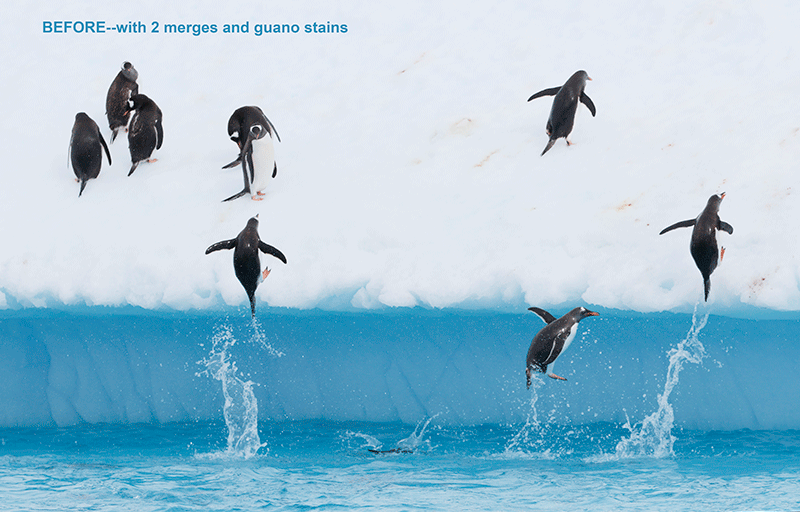
Please pardon the clean-upe typo. 🙂 |
The Image Optimization
Like all of my new work, this image was converted in Canon’s Digital Photo Professional, this one yesterday in DPP v 4.1.50.0. The latest version adds support for the EOS-7D and the EOS-1D Mark IV. The charts in the updated version of the DPP 4 Raw Conversion Guide includes sharpness and noise reduction values for the 7D Mark II. We will be adding values for the 7D and the 1D Mark IV within a week or two.
Take a careful look at the Before and After animated GIF above. Note the elimination of the two unpleasantly merged penguins. I used the Protective Cloning on a Layer Technique taught to me by Denise Ippolito. This technique involves working on a Layer with a Regular Layer Mask added. The guano was eliminated with my usual clean-up tools, the Patch Tool, the Spot Healing Brush, and the Clone Stamp.
Image Question
Would you have removed the left-most penguin from the optimized version?
Digital Basics
Everything that I did to optimize today’s images is covered in detail in my Digital Basics File–written in my easy-to-follow, easy-to-understand style. Are you tired of making your images look worse in Photoshop? Digital Basics File is an instructional PDF that is sent via e-mail. It includes my complete digital workflow, dozens of great Photoshop tips (including the Surface Blur settings as taught to me by Denise Ippolito), details on using all of my image clean-up tools, the use of Contrast Masks, several different ways of expanding and filling in canvas, all of my time-saving Keyboard Shortcuts, Quick Masking, Layer Masking, and NIK Color Efex Pro basics, Contrast Masks, Digital Eye Doctor techniques, using Gaussian Blurs, Tim Grey Dodge and Burn, a variety of ways to make selections, how to create time-saving actions, and tons more.
APTATS I & II
Learn the details of advanced Quick Masking techniques in APTATS I. Learn Advanced Layer Masking Techniques in APTATS II. Mention this blog post and apply a $5 discount to either with phone orders only. Buy both APTATS I and APTATS II and we will be glad to apply at $15 discount with phone orders only. Please call Jim or Jennifer at 863-692-0906 weekdays to order.
The Bosque Site Guide
All BAA Site Guides are designed so that with a bit of study you can show up at a great place and know exactly where to be at what time on what wind and in what lighting conditions. With a Site Guide on your laptop you will feel like a 20-year veteran even on your first visit. Site Guides are the next best thing to being on an IPT. If you plan on visiting the refuge it would be foolish to make the trip without having this guide in hand. Why spend money on gear and travel and then spend days stumbling around in the wrong spots? If you have visited previously, and are still unsure of where you should be at this time of day with that wind, this guide will prove invaluable to you as well.
You can order yours here or check out all of our site guides here.
|
In 2015, we are offering a 3-DAY IPT before Thanksgiving and a 4-DAY IPT after the holiday. You can attend either and spend Thanksgiving Day with your family. Sign up for both and we will be glad to apply a $100 discount to your balance. We know that there are lots of less costly workshops being offered these days. Please remember that you get exactly what you pay for. If you want the finest in photographic instruction and want to be assured of being in the right spot at exactly the right time, do join us. |
Bosque del Apache 2015 BIRDS AS ART/A Creative Adventure Instructional Photo-Tour (IPT). 3-FULL DAY IPT: NOV 22-24, 2015. $1149. Meet and greet and introductory slide program after dinner on your own at 7:00pm on SAT NOV 21.
Tens of thousands of Snow Geese, 10,000 Sandhill Cranes, ducks, amazing sunrises, sunsets, and blast-offs. Live, eat, and breathe photography with two of the world’s premier photographic educators at one of their very favorite photography locations on the planet. Top-notch in-the-field and Photoshop instruction. This will make 21 consecutive Novembers at Bosque for artie. This will be denise’s 7th workshop at the refuge. Nobody knows the place better than artie does. Join us to learn to think like a pro, to recognize situations and to anticipate them based on the weather, especially the sky conditions, the light, and the wind direction. Every time we make a move we will let you know why. When you head home being able to apply what you’ve learned on your home turf will prove to be invaluable.
This workshop includes 3 morning and 3 afternoon photography sessions, an inspirational introductory slide program after dinner on your own on Saturday, 11/21, all lunches, and after-lunch digital workflow, Photoshop, and image critiquing sessions.
There is never a strict itinerary on a Bosque IPT as each day is tailored to the local conditions at the time and to the weather. We are totally flexible in order to maximize both the photographic and learning opportunities. We are up early each day leaving the hotel by 5:30 am to be in position for sunrise. We usually photograph until about 10:30am. Then it is back to Socorro for lunch and then a classroom session with the group most days. We head back to the refuge at about 3:30pm each day and photograph until sunset. We will be photographing lots of Snow Geese and lots of Sandhill Cranes with the emphasis on expanding both your technical skills and your creativity.
A $449 non-refundable deposit is required to hold your slot for this IPT. Your balance, payable only by check, will be due on 7/25/2015. If you cancel and the trip fills, we will be glad to apply a credit applicable to a future IPT for the full amount less a $100 processing fee. If we do not receive your check for the balance on or before the due date we will try to fill your spot from the waiting list. Whether or not your spot is filled, you will lose your deposit. If not, you can secure your spot by paying your balance.
Please print, complete, and sign the form that is linked to here and shoot it to us along with your deposit check (made out to “Arthur Morris.”) You can also leave your deposit with a credit card by calling the office at 863-692-0906. If you register by phone, please print, complete and sign the form as noted above and either mail it to us or e-mail the scan. If you have any questions, please feel free to contact me via e-mail.
|
In 2015, we are offering a 3-DAY IPT before Thanksgiving and a 4-DAY IPT after the holiday. You can attend either and spend Thanksgiving Day with your family. Sign up for both and we will be glad to apply a $100 discount to your balance. We know that there are lots of less costly workshops being offered these days. Please remember that you get exactly what you pay for. If you want the finest in photographic instruction and want to be assured of being in the right spot at exactly the right time, do join us. |
Bosque del Apache 2015 BIRDS AS ART/A Creative Adventure Instructional Photo-Tour (IPT). 4-DAY IPT: (three full and two 1/2 DAYS) NOV 28-DEC 2, 2015. $1499. Meet and greet at 3pm on SAT NOV 28 followed by an afternoon photo session at the crane pools and the introductory slide program after dinner on your own.
Tens of thousands of Snow Geese, 10,000 Sandhill Cranes, ducks, amazing sunrises, sunsets, and blast-offs. Live, eat, and breathe photography with two of the world’s premier photographic educators at one of their very favorite photography locations on the planet. Top-notch in-the-field and Photoshop instruction. This will make 21 consecutive Novembers at Bosque for artie. This will be denise’s 7th workshop at the refuge. Nobody knows the place better than artie does. Join us to learn to think like a pro, to recognize situations and to anticipate them based on the weather, especially the sky conditions, the light, and the wind direction. Every time we make a move we will let you know why. When you head home being able to apply what you’ve learned on your home turf will prove to be invaluable.
This workshop includes 4 afternoon (11/28through 12/1), 4 morning (11/29 to 12/2) photography sessions, an inspirational introductory slide program after dinner on your own on Saturday, 11/28, all lunches, and after-lunch digital workflow, Photoshop, and image critiquing sessions.
There is never a strict itinerary on a Bosque IPT as each day is tailored to the local conditions at the time and to the weather. We are totally flexible in order to maximize both the photographic and learning opportunities. We are up early each day leaving the hotel by 5:30 am to be in position for sunrise. We usually photograph until about 10:30am. Then it is back to Socorro for lunch and then a classroom session with the group most days. We head back to the refuge at about 3:30pm each day and photograph until sunset. We will be photographing lots of Snow Geese and lots of Sandhill Cranes with the emphasis on expanding both your technical skills and your creativity.
A $599 non-refundable deposit is required to hold your slot for this IPT. Your balance, payable only by check, will be due on 7/25/2015. If you cancel and the trip fills, we will be glad to apply a credit applicable to a future IPT for the full amount less a $100 processing fee. If we do not receive your check for the balance on or before the due date we will try to fill your spot from the waiting list. Whether or not your spot is filled, you will lose your deposit. If not, you can secure your spot by paying your balance.
Please print, complete, and sign the form that is linked to here and shoot it to us along with your deposit check (made out to “Arthur Morris.”) You can also leave your deposit with a credit card by calling the office at 863-692-0906. If you register by phone, please print, complete and sign the form as noted above and either mail it to us or e-mail the scan. If you have any questions, please feel free to contact me via e-mail.
Be sure to like and follow BAA on Facebook by clicking on the logo link upper right. Tanks a stack!
Support the BAA Blog. Support the BAA Bulletins: Shop B&H here!
We want and need to keep providing you with the latest free information, photography and Photoshop lessons, and all manner of related information. Show your appreciation by making your purchases immediately after clicking on any of our B&H or Amazon Affiliate links in this blog post. Remember, B&H ain’t just photography!




Amazon.com
Those who prefer to support BAA by shopping with Amazon may use this link:
Amazon Canada
Many kind folks from north of the border, eh, have e-mailed stating that they would love to help us out by using one of our affiliate links but that living in Canada and doing so presents numerous problems. Now, they can help us out by using our Amazon Canada affiliate link by starting their searches by clicking here. Many thanks to those who have written.
Typos
In all blog posts and Bulletins, feel free to e-mail or to leave a comment regarding any typos or errors. Just be right :).

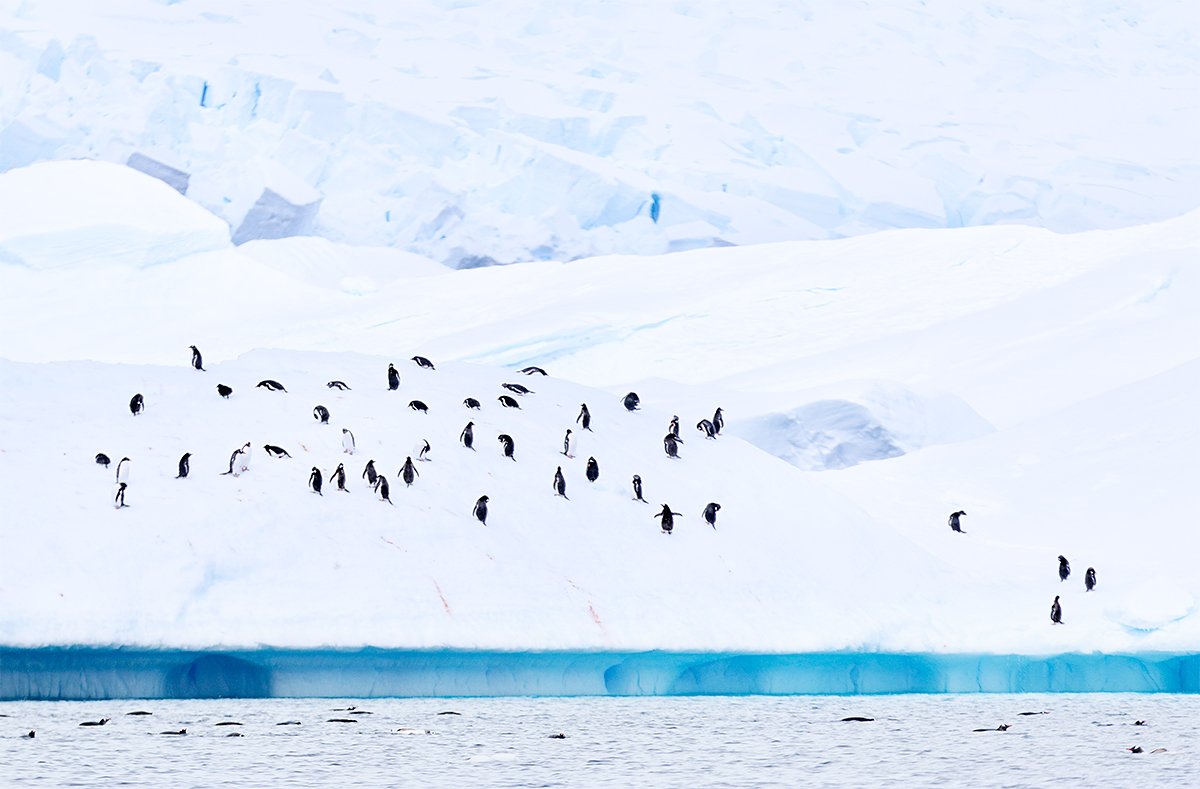
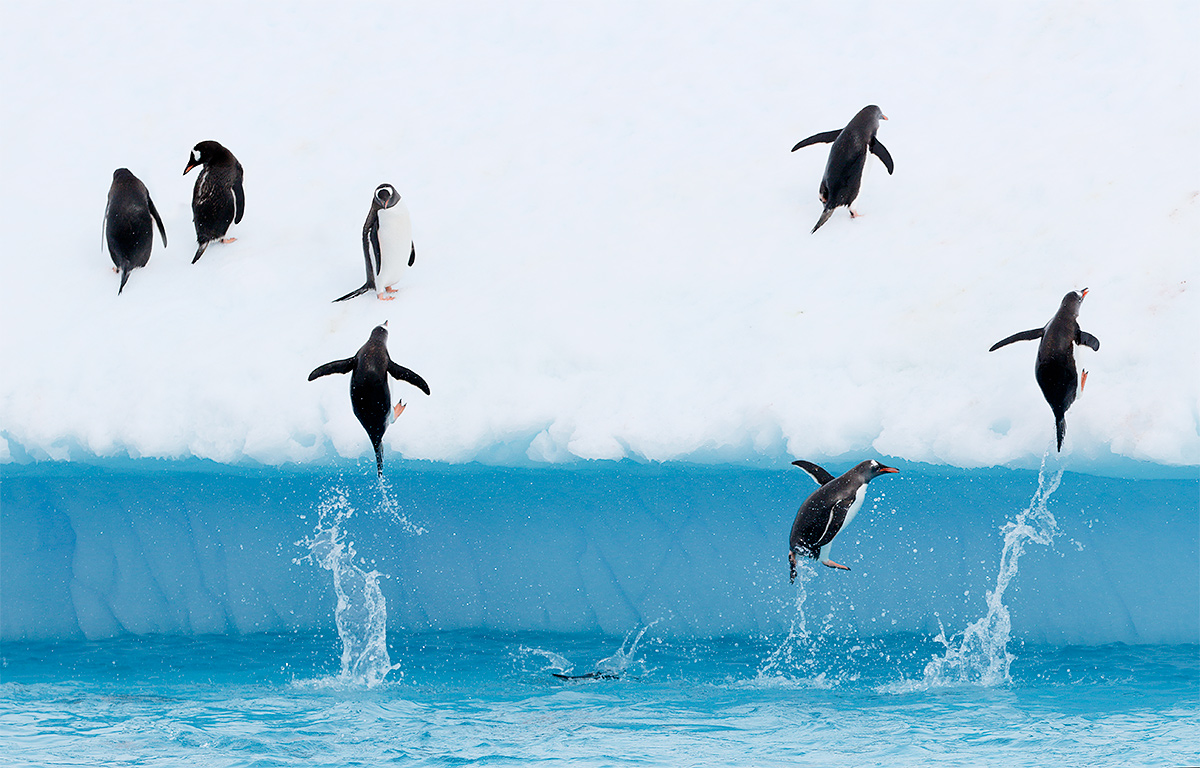
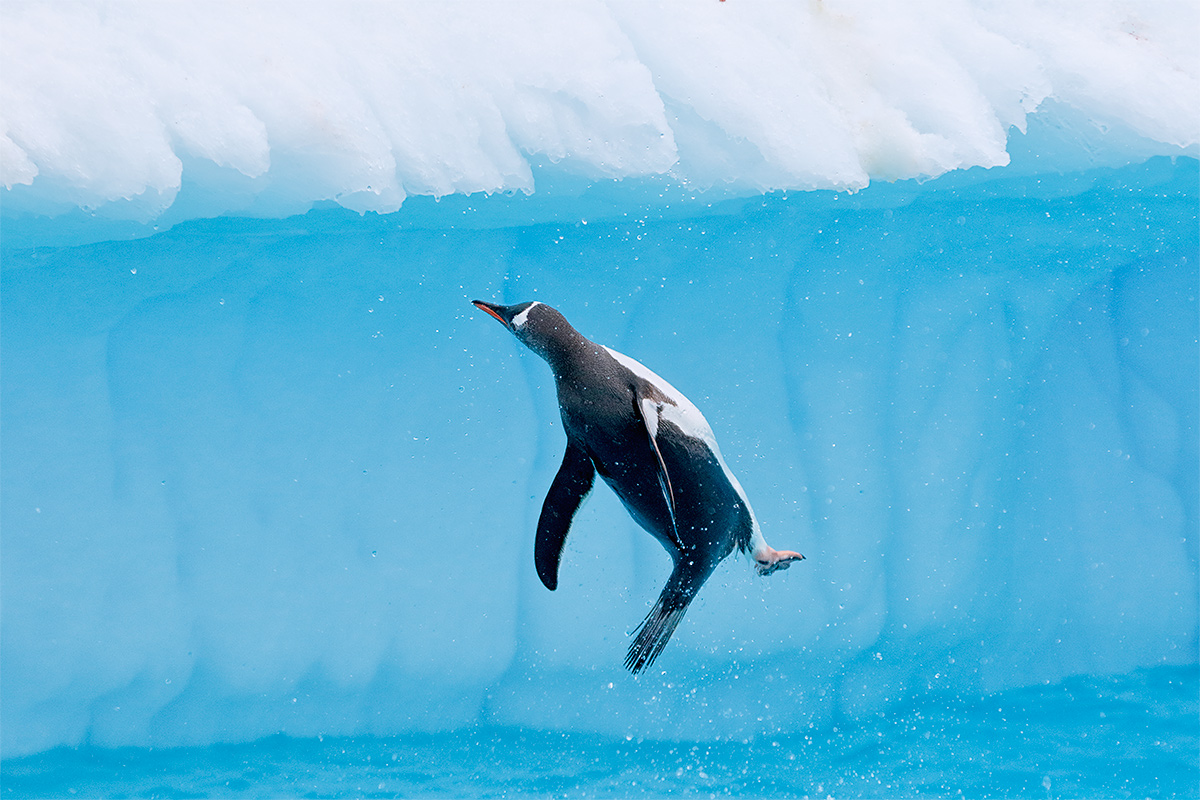
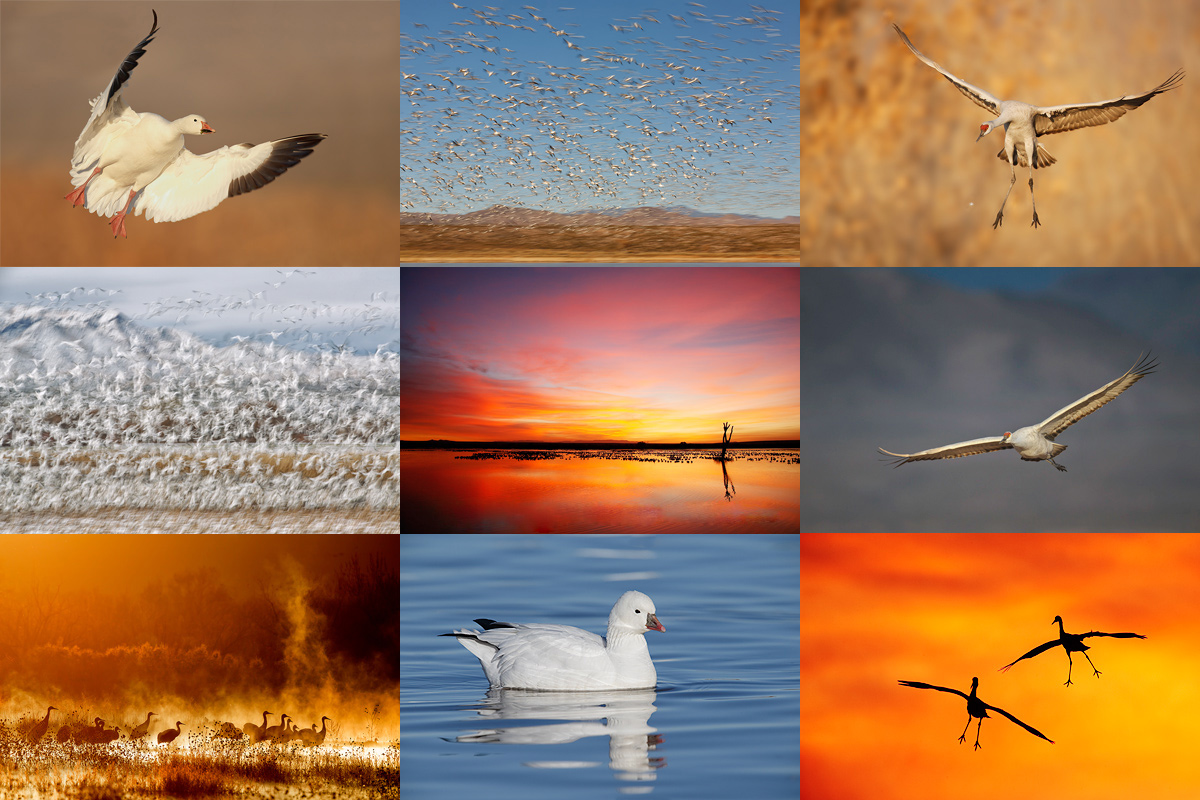
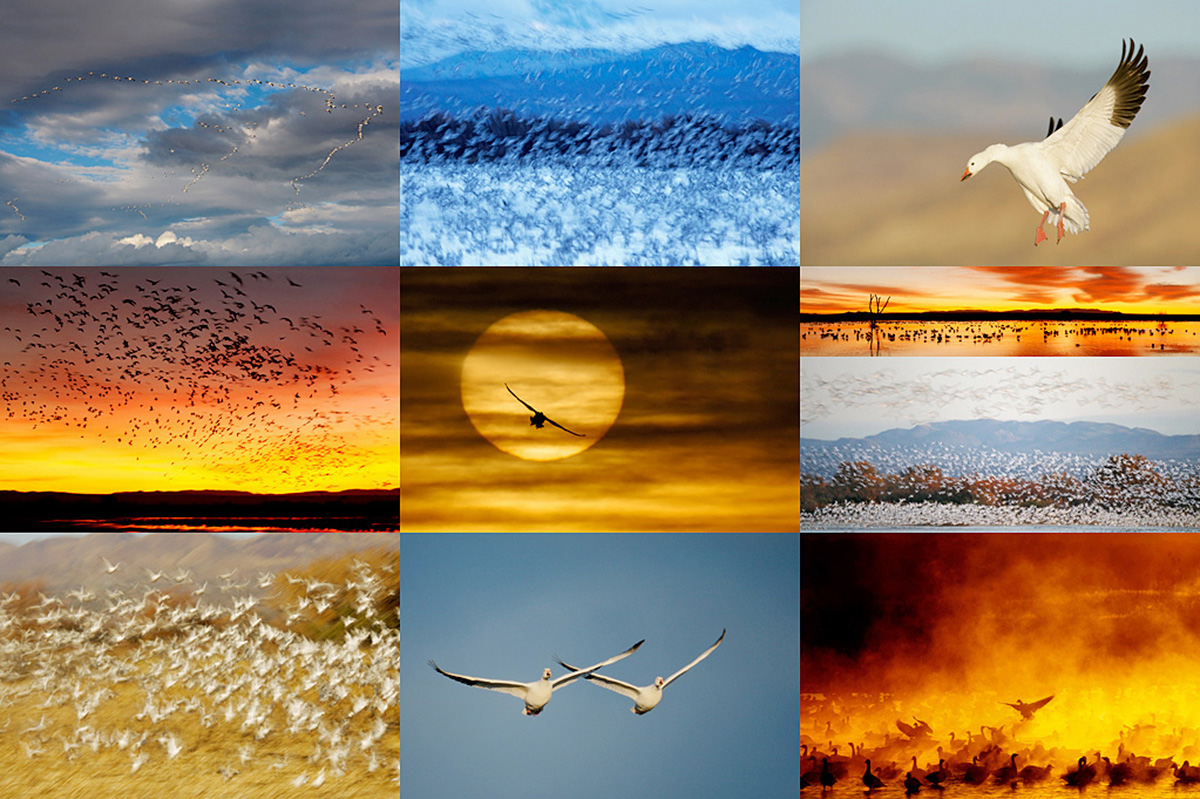













In the two left pairs one bird is looking at the other – NICE!
Very cool image!!
Thanks. Which one? a
The multiple penguin shot.
Thnx. a
I agree with Jim. As soon as I looked at the image I thought what would the second bird look at if the first were removed. You need the left most bird. Perhaps if you removed them both you might get something but I think it would then be unbalanced.
Keep on teaching.
I would not remove the leftmost penguin. It gives the next bird something to look at and contains the image. One bird looking out of the frame alone would look bad in my idea of framing. Wish I could have been there. Spectacular, Artie, thanks.